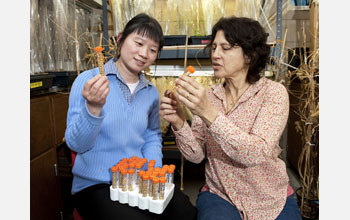Multimedia Gallery
Starch-controlling Gene Fuels Protein
Researchers at Iowa State University (ISU) have introduced a newly discovered gene, found only in Arabidopsis thaliana plants, into soybean plants and increased the amount of protein in the soybean seeds by 30 to 60 percent.
The research was performed by Eve Wurtele, professor of genetics, development and cell biology at ISU, and Ling Li, an adjunct assistant professor and an associate scientist working in her lab.
When the researchers neutralized the gene, known as QQS, in Arabidopsis, they discovered the gene was involved in regulating starch accumulation, called deposition.
"Based on the changes in activities of other genes that occurred when we altered QQS, we conjectured that it wasn't directly involved in starch synthesis, but rather it may be involved in altering [the plant's] composition in general," said Wurtele. "We decided to test this concept by transferring the gene to an agronomically important plant species, soybean, which has a seed and is important as a source of vegetable protein and oil."
"We found that the QQS transgene increased protein production in the soybean seed," she added. "That was the best possible scenario."
The discovery has potential to help people in areas who survive on protein-deficient diets and holds promise for helping meet the nutritional needs of a hungry world.
This research was supported in part by funding from the National Science Foundation and ISU's Plant Science Institute. To learn more, see the ISU news story Starch-controlling gene fuels more protein in soybean plants. (Date of Image: 2011)
Credit: ISU photo by Bob Elbert
Images and other media in the National Science Foundation Multimedia Gallery are available for use in print and electronic material by NSF employees, members of the media, university staff, teachers and the general public. All media in the gallery are intended for personal, educational and nonprofit/non-commercial use only.
Images credited to the National Science Foundation, a federal agency, are in the public domain. The images were created by employees of the United States Government as part of their official duties or prepared by contractors as "works for hire" for NSF. You may freely use NSF-credited images and, at your discretion, credit NSF with a "Courtesy: National Science Foundation" notation.
Additional information about general usage can be found in Conditions.
Also Available:
Download the high-resolution JPG version of the image. (5.8 MB)
Use your mouse to right-click (Mac users may need to Ctrl-click) the link above and choose the option that will save the file or target to your computer.

